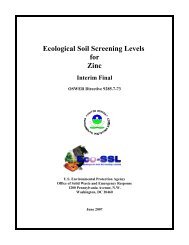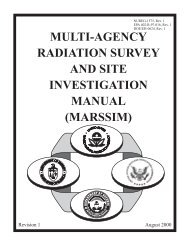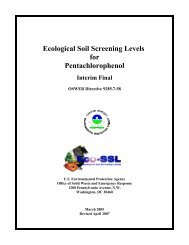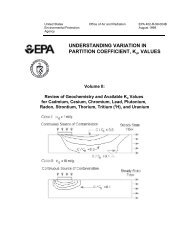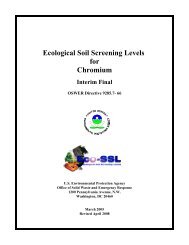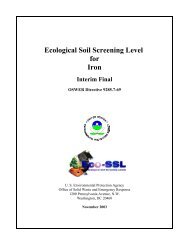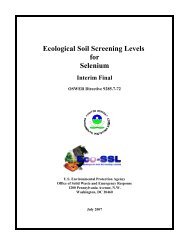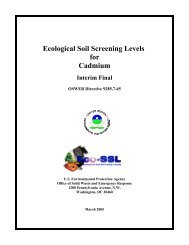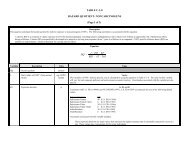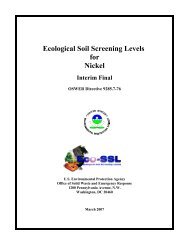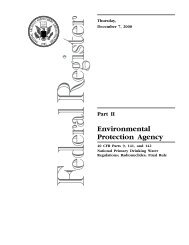Guidance for Conducting Risk Assessments and Related Risk ...
Guidance for Conducting Risk Assessments and Related Risk ...
Guidance for Conducting Risk Assessments and Related Risk ...
You also want an ePaper? Increase the reach of your titles
YUMPU automatically turns print PDFs into web optimized ePapers that Google loves.
• document the magnitude of risk <strong>and</strong> the primary causes of that risk, <strong>and</strong><br />
• define Remedial Goal Options (RGOs).<br />
Note: During the preparation of the baseline human health risk assessment, newly acquired data will be<br />
incorporated in the watershed database <strong>and</strong> the modified data set will again be compared to risk-based<br />
PRGs. This comparison may result in the identification of early actions (including removals <strong>and</strong> interim<br />
actions) in order to reduce risks <strong>and</strong>/or accelerate the clean-up process.<br />
Figure 2<br />
Scoping Workshop<br />
Site Characterization<br />
Establish Remedial<br />
Goal Options (RGOs)<br />
Figure 4<br />
2.2.3 Feasibility Study<br />
Early Action<br />
(e.g. removal,<br />
interim action<br />
The Project Scoping Workshop <strong>and</strong> <strong>Risk</strong> Assessment<br />
• compile existing data,<br />
• develop a conceptual site model,<br />
• develop risk-based PRGs <strong>and</strong> screen data to identify early,<br />
actions <strong>and</strong> chemicals of potential concern,<br />
• develop RI/FS data quality objectives,<br />
• focus additional sampling <strong>and</strong> anlaysis ef<strong>for</strong>ts of chemicals of<br />
potential concern, <strong>and</strong><br />
• provide justification <strong>for</strong> no further action.<br />
Site Characterization <strong>and</strong> <strong>Risk</strong> Assessment<br />
• help determine whether additional response action is necessary,<br />
• provide evaluations of the effectiveness of actions (where appropriate),<br />
• document the magnitude of risk <strong>and</strong> the primary causes of that risk, <strong>and</strong><br />
• define uncertainties.<br />
No Further<br />
Action<br />
Remedial Goal Options <strong>and</strong> <strong>Risk</strong> Assessment<br />
• incorporate results of baseline risk assessment,<br />
• calculate RGOs <strong>for</strong> contaminants of concern by media, using site-specific exposure parameters, &<br />
• identify ARARs.<br />
Figure 3. Site characterization <strong>and</strong> risk assessment<br />
The selection of an appropriate remedial action begins with a screening of potential alternatives<br />
during the initial scoping workshop. This is conducted prior to the development of the RI work plan<br />
(Fig. 4). The preliminary screening of alternatives is refined as more in<strong>for</strong>mation becomes available <strong>and</strong><br />
the results of the baseline ecological <strong>and</strong> human health risk assessments determine the chemicals <strong>and</strong><br />
pathways of concern. During the selection of remedial actions, short-term <strong>and</strong> long-term risks must be<br />
considered. The analysis of short-term risks focuses on the potential adverse effects on human health <strong>and</strong><br />
the environment from implementation of the remedial action. The analysis of long-term risks focuses on<br />
the risk that will remain after remedial action has been taken (this level of remaining risk is termed<br />
residual risk). These analyses may be either qualitative or quantitative, depending on site conditions. For<br />
more in<strong>for</strong>mation, refer to page 14 of <strong>Risk</strong> Assessment <strong>Guidance</strong> <strong>for</strong> Superfund, Part C (EPA 1991b).<br />
14



